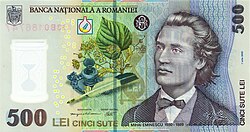| Country | Romania |
|---|---|
| Value | 500 Romanian leu |
| Width | 153 mm |
| Height | 82 mm |
| Security features | watermark, security thread, transparent window, microprinting, blacklight printing, micro perforations, latent writing, EURion constellation, colour-changing ink, ultraviolet ink, security thread, serial number |
| Material used | polymer |
| Years of printing | since 2005 |
| Obverse | |
 | |
| Design | Mihai Eminescu, Tilia, writing instruments (feather and ink cartridge) |
| Designer | National Bank of Romania |
| Design date | 2005 |
| Reverse | |
 | |
| Design | ”Mihai Eminescu” Central University Library of Iași, Timpul newspaper |
| Designer | National Bank of Romania |
| Design date | 2005 |
The five hundred lei banknote is the highest of the circulating denomination of the Romanian leu. It is the same size as the 200 Euro banknote.
The main color of the banknote is gray. It pictures, on the obverse poet Mihai Eminescu, and on the reverse the ”Mihai Eminescu” Central University Library of Iași, and the front page of the Timpul newspaper.





